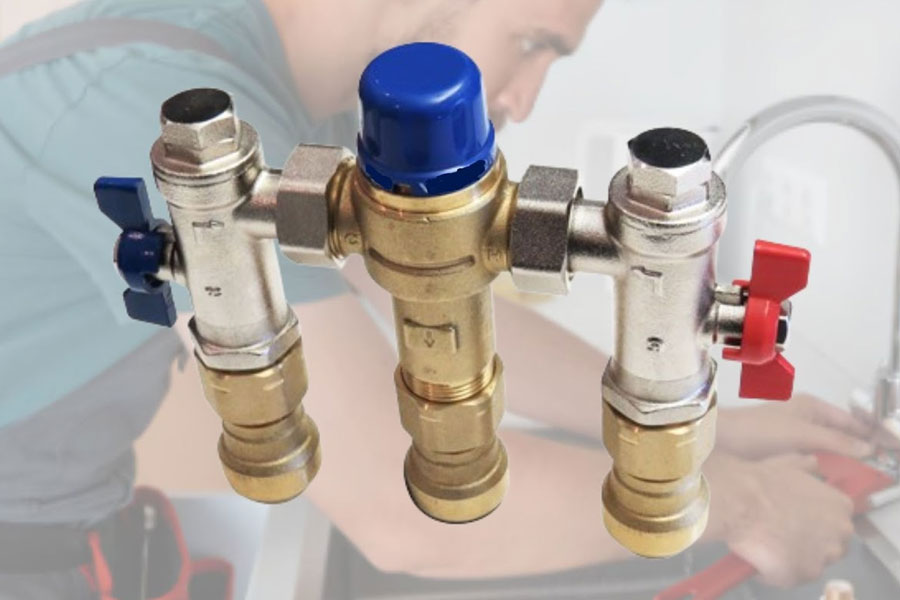Enquire Now
- CALL A PLUMBER
- (925) 478-8073
Enquire Now
 September 10, 2025
September 10, 2025
If you’ve ever stepped into a shower that went from cozy to burning hot when someone flushed a toilet, you’ve felt the problem a tempering valve solves. This small device blends hot and cold water to a safe, steady temperature before it reaches your taps. For families in San Ramon and across the Tri-Valley, it’s one of the simplest ways to enhance safety, comfort, and code compliance. That too, without replacing your water heater.
At Magnificent Plumbing & Rooter in San Ramon, CA, installations and servicing of tempering valves keep us busy. Below, you’ll learn what they are, how they work, and the clearest signs you might need one.
A tempering valve automatically mixes hot as well as cold water to maintain a set outlet temperature. Inside the valve, a thermal element expands or contracts as water temperature changes. As a result, the valve constantly adjusts the hot/cold blend so what comes out of your shower or faucet stays within a safe range, even if pressures or supply temperatures shift.
It’s a fair question. Turning down the heater helps, but it isn’t a complete safety plan. First, a water heater thermostat isn’t a scald protection device. Codes and inspectors do not consider it an approved control because it can’t react fast to pressure changes at the fixtures. California guidance makes that point explicit and limits the temperature of delivered hot water at bathtubs and public lavatories to 120°F, with approved mixing devices (not the water-heater dial) used to meet that limit.
Second, there’s a health reason to keep stored water hotter. Public-health agencies advise storing hot water above 140°F to reduce the risk of Legionella bacteria in the system, then using mixing valves to temper the water down to a safe delivery temperature at your taps.
Scalds happen quickly. At 140°F, severe burns can occur in seconds. Even at 130°F, it can take only about 30 seconds to suffer a severe injury. Keeping delivered hot water around 120°F significantly reduces that risk, especially for kids and older adults. A tempering valve helps hold that line, even when someone starts a load of laundry mid-shower.
When there is a pressure imbalance and supply variation, the water you get is hot, then cold, and then hot again. A properly sized tempering valve smooths out those swings so showers feel consistent, faucets run at a predictable temperature, and you get fewer complaints from the household. Tempering valves deliver a constant outlet temperature despite changes in supply conditions, which is exactly what your morning routine needs.
Because a tempering valve blends in cold water, you can safely store water at a higher temperature and still deliver 120°F at the fixture. That effectively stretches your tank’s capacity during peak-demand times (think back-to-back showers), often postponing the need for a larger water heater. It’s a practical upgrade when you’re not ready to replace equipment.
In California, anti-scald protection isn’t optional in many scenarios. Showers and tub-showers use ASSE 1016 “automatic compensating” valves, while bathtubs and public-use lavatories must limit delivered hot water to 120°F. Importantly, the water heater thermostat alone can’t be used to satisfy this requirement; a mixing valve must be installed.
There are three common placements:
At Magnificent Plumbing & Rooter, we start by checking your water heater type, recirculation loop (if any), plumbing layout, and fixture mix. Then we size a valve for your home’s flow rate and pressure. For most San Ramon and nearby homes, a master mixing valve near the heater plus anti-scald shower valves offers reliable, code-compliant protection.
After installation, you should:

Call Magnificent Plumbing & Rooter in San Ramon for a free estimate on a tempering valve install. We’ll check your system, explain your options, and help you pick the setup suitable for your home and budget.
You’ll reduce risk, but you won’t get active protection against sudden changes in pressure or temperature. Also, many homes benefit from storing water hotter (for capacity and hygiene) and then tempering it down at delivery. That’s what a tempering valve does best.
When sized correctly, pressure and flow feel normal. We right-size the valve so your showers stay strong and steady.
In everyday use, people treat them the same. In the code world, you’ll see different ASSE numbers for where and how the valve is used (whole system, shower, or point-of-use). We’ll choose the right one for your application.
Yes. California guidance caps delivery at 120°F for several fixtures, and burn-injury data strongly support that limit. Meanwhile, storing hotter and tempering down provides both safety and performance.